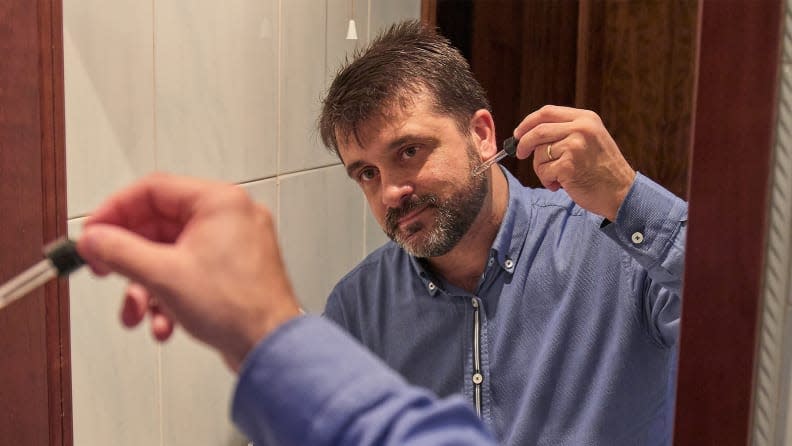Hammerling-Hodgers: Got a beard? If you don't properly care for it, bad things can happen
Beards have long been a trendy look for men.
Over the years, the scruffy lumberjack look seems to be evolving into a better-maintained, more professional and shaped beard.
Regardless of what the trend is currently, beards are in, and I believe the pandemic has a lot to do with that.
With many still working remotely — or not working at all — and with few social events going on, there’s little motivation to shave.
I've seen a lot more beards and stubbled faces over the past two years and I think that’s going to continue into 2022.
“For many men, a beard is important culturally, while for others, it is simply a prominent feature of their person and their look,” says Yale Medicine dermatologist Dr. Brett A. King. “Some men would feel less like themselves — or even less like a man — without it.”
Susan's previous three columns:
Prostate cancer: It's the second-most common cancer for men; know the signs
Know the signs: Signs of domestic violence may not be as obvious as many might think
Know the science: Vaccines have stopped widespread chicken pox, measles outbreaks in U.S.
More men sporting beards and mustaches, however, also means many skin care professionals are seeing more problems.
Yale dermatologist Dr. David J. Leffell, chief of dermatologic surgery and author of Total Skin, notes there are inherent grooming and skin care issues that come along with facial hair.
Here’s how to manage:

Skin irritation
Most men have experienced razor burn — so much so that for some men, avoiding that redness and stinging are a reason to bench the smooth shave.
But growing a beard doesn’t mean a man should stop shaving altogether; many still need to shave some spots (like the neck).
Skin irritation caused by shaving is called "irritant contact dermatitis."
Dull razors (even on electric razor heads) can increase the risk. So can blades that don’t contour to your face.
“Sometimes it is caused by simply shaving too closely, which leads to friction,” says dermatologist Dr. Christopher G. Bunick.
Chemicals and fragrances in shave creams, gels and pre-shave lotions can increase skin sensitivity, breaking down the outer barrier of the skin that’s responsible for protection, says Dr. Bunick.
An assistant professor at Yale School of Medicine, he does research on what compromises the skin’s barrier function — and how to restore it. A good bet, he says, is to use fragrance-free, emollient creams and moisturizers after shaving.
Below are some other tips to cool razor burn.
What you should do: Opt for a four- or five-blade razor, which can help bypass irritation.
Apply an emollient facial cream post-shaving.
Sometimes a dermatologist might also prescribe hydrocortisone cream to soothe itching, redness and burning.
What you should not do: It’s never a good idea to shave “up” against the grain of your beard, says dermatologist Dr. Keith A. Choate, who is also a professor of dermatology at Yale School of Medicine. Instead, move the razor in a downward motion, which will be less likely to cause irritation.
Ingrown hairs
Guys with curly facial hair may develop ingrown hairs, also known as "pseudo folliculitis barbae."
This happens during the stubble phase, when hairs first sprout from follicles and then curl back into the skin. “The resulting red, raised bumps on the skin are often unsightly, painful, or itchy,” says Dr. Bunick.
Razors that lift hair before cutting actually contribute to the problem.
“This lifting process can cause the top of the just-cut hair to descend below the skin surface, where it causes inflammation, leading to the red bumps,” he says.
Preventing ingrown hairs is possible.
What you should do: Pass on the clean shave and maintain a beard or scruff. Ingrown hairs happen where you cut your facial hair off, such as the neck area.
Shave after showering rather than before. This reduces the likelihood ingrown hairs will develop, says Dr. Choate.
Use a new razor. If using an electric razor, use a shave guard to prevent shaving too close to the skin.

For areas to be shaved, apply a pre-shave oil to the beard area, and let it penetrate for 30 seconds. Then apply unscented shave cream and work into a lather. Follow up with a post-shave moisturizer.
Ask your dermatologist if laser hair removal might be an option for problem zones, such as the neck. Laser hair removal costs hundreds of dollars, though, so be sure it's worth the investment.
What you should not do: Though it seems counter-intuitive, it is not a good idea to press down on the razor or to spread the skin surface taut while shaving. Though both these techniques give a closer shave, they increase the likelihood of getting ingrown hairs.
Sparse or spotty hair growth
If you’re dissatisfied with a beard or a mustache that’s too thin, it’s probably dad or mom’s fault.
The ability to grow thick facial hair, it turns out, tends to run in families, says Dr. Leffell, creating challenges for men who want a beard but aren’t genetically gifted in that department.
And, according to a survey by the grooming company Braun, 77 percent of New York men surveyed who don’t have facial hair say they would grow it if they could.
It’s also important to know that hair loss can affect the beard. Some men with male-patterned baldness (androgenic alopecia) successfully undergo beard transplants from human donors.
Other men may discover they have complete or spotty hair loss in the beard area, which could be a sign of alopecia areata, an autoimmune disease.
“Men with this condition will notice a faintly spotted face early in the day after shaving that’s impossible to ignore by noon when there is a shadow of stubble,” says Dr. King, who is an expert in alopecia areata.
What you should do: Have a dermatologist evaluate the cause of your hair loss and suggest treatment that may work for you.
For example, Dr. King has led groundbreaking research on an arthritis drug called Xeljanz.
In clinical trials, it has been shown to successfully regrow scalp hair, but Dr. King reports that facial hair often responds to treatment, too.
What you should not do: Give up. If having uneven prickles that don’t fill in is an issue for you, consider trying different styles of facial hair — perhaps two- or three-day scruff is right for how your hair grows.
Beard dandruff
A skin condition called seborrheic dermatitis can leave unattractive flakes in your beard.
Though it looks a lot like a hygiene problem, it’s not.
While some causes of seborrheic dermatitis remain unknown, one thing experts say can cause it is a yeast on the skin called Malassezia.
In some people whose immune systems mount a robust reaction to this variety of yeast, a scaly, flaky rash can develop on the scalp, eyebrows, nose, mustache and beard area. (It can affect the groin, too.)
While there is no cure, here’s how to cope.
What you should do: Try an over-the-counter dandruff shampoo, containing 1 percent ketoconazole.
Apply it to dry skin and leave it on for five minutes before showering. It may not be a perfect solution, cautions Dr. Choate.
“While this will clear the scale, dark or light spots can persist for months,” he says.
Shampoos containing selenium sulfide and pyrithione zinc may also be effective.
Your dermatologist can also prescribe other topical solutions to help.
What you should not do: Petroleum jelly is not a good soothing choice. According to the American Academy of Dermatology (AAD), it tends to make seborrheic dermatitis worse.
This is often a chronic condition, so don’t stop treating the skin.
“It’s very common for patients to return, saying the medicines cleared the rash, but it recurred when they stopped using it,” says Dr. Bunick.
Bumps in the beard
Not all beard blemishes are caused by ingrown hairs or acne. Sometimes a benign bump, such as a mole or a benign actinic keratosis, may appear. Or you might find something that should be biopsied.
“Skin cancers, including basal cell carcinoma, squamous cell carcinoma, and melanoma, can hide in the beard hair,” says Dr. Bunick. They often go unnoticed until they become bothersome. Here’s what to do if you detect something suspect in your facial hair:
What you should do: Have beard bumps evaluated by a board-certified dermatologist who can determine the cause.
What you should not do: Skip skin checks. Make sure to be alert for bumps under your facial hair that are new, changing, raised, asymmetrical or bleeding.
“This should be a regular part of a man’s grooming routine; it could be lifesaving,” says Dr. Bunick.
Pimples
Causes: Folliculitis is most often caused by an infection of hair follicles with Staphylococcus aureus (staph) bacteria.
Folliculitis may also be caused by viruses, fungi and even an inflammation from ingrown hairs.
Follicles are densest on your scalp, and they occur everywhere on your body except your palms, soles, lips and mucous membranes.
Risk factors: Anyone can develop folliculitis. But certain factors make you more susceptible to the condition, including:
Having a medical condition that reduces your resistance to infection, such as diabetes, chronic leukemia and HIV/AIDS.
Having acne or dermatitis.
Taking some medications, such as steroid creams or long-term antibiotic therapy for acne.
Being a male with curly hair who shaves.
Regularly wearing clothing that traps heat and sweat, such as rubber gloves or high boots.
Soaking in a hot tub that's not maintained well.
Causing damage to hair follicles by shaving, waxing or wearing tight clothing.
Complications: Possible complications of folliculitis include:
Recurrent or spreading infection.
Boils under the skin (furunculosis).
Permanent skin damage, such as scarring or dark spots.
According to the AAD, acne is the most common skin condition in America. Though you might think it should have ended with high school, acne can strike at any age.
That’s particularly so for people with facial hair, since it boosts the odds you’ll develop pimples under your beard. That’s because acne develops when the skin produces a lot of sebum (oil) and dead skin cells don’t shed properly. The oil and dead skin cells mix with bacteria on the skin's surface, causing breakouts. Here’s how to strike acne out for good:
What you should do: Wash your face (including your beard) twice a day, using a gentle skin cleanser. And use a topical anti-acne medication, containing salicylic acid, benzoyl peroxide or retinoids, available over the counter. A dermatologist can prescribe other medications to get you in the clear.
Keep at it.
“Unfortunately, most acne medicines take two to three months to reach full effectiveness, and it takes about 28 days for skin to cycle or shed,” says Dr. Bunick. “So, patience is needed to get clear skin.”
What you should not do: While they can help to soften sharp quills, beard oils can promote acne in those who are already acne-prone. Think about skipping the beard oil if you breakout easily.
“Stroking your mustache or beard might look cool, but you’re delivering bacteria to your face that can cause acne,” says Dr. Choate. Hands off!
It is essential for a man to take pride in his beard and to care for it. Regular grooming, washing and oiling to treat the hair.
Trimming the stragglers and keeping a clean neckline all make for a presentable beard.”
This article originally appeared on Florida Today: If beards aren't properly maintained, many skin issues can occur

